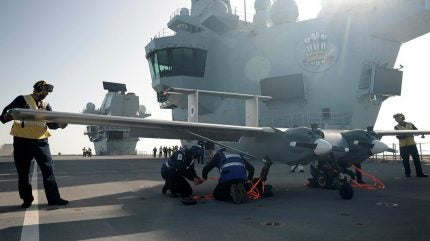
The UK Royal Navy wants to accelerate a range of concepts to the minimum viable product stage within its existing uncrewed aerial system (UAS) heavy-lift capability (HLC) framework to better understand potential options and operational uses in the market.
Such concepts will be used predominantly, but not exclusively, in the maritime domain according to the open opportunity notice released earlier this month. The HLC is aiming for a 200kg payload capability.

Discover B2B Marketing That Performs
Combine business intelligence and editorial excellence to reach engaged professionals across 36 leading media platforms.
No limit has been placed on the number of concepts that may be developed, but certain factors will need to be considered first, not least funding availability.
The current framework remains available for use across Defence until August 2026.
The intention is to address the lack of current options in the market by increasing the number of delivery ready platforms. This will give the government access to heavy-lift UAS “at the speed of relevance,” in other words, as technology evolves.
Flexible procurement
Diverging from their prescriptive measures for procurement, the Ministry of Defence (MoD) hopes to cultivate a competitive industrial ecosystem whereby suppliers are able to demonstrate their current capabilities, set out product development and commercial exploitation roadmaps, and work with both the government and potentially other suppliers to accelerate pace of development and reduce time to market.

US Tariffs are shifting - will you react or anticipate?
Don’t let policy changes catch you off guard. Stay proactive with real-time data and expert analysis.
By GlobalDataThis contrasts with previous methods the MoD used to procure, for example, the German-made Remote Controlled Howitzer-155 system for its Mobile Fires Programme in May 2024, when the former government ditched the South Korean K9 howitzer without a competitive process at all.
Autonomous Maritime Aviation
Currently the naval force operate numerous crewed rotorcraft types, including 28 AW159 Wildcat attack helicopters and more than 50 Merlin anti-submarine warfare platforms – the original Mark 1 Merlin units were procured from as early as the late 1990s.
In an effort to expand the future capabilities and mass of its maritime aviation inventory, the Navy will field new uncrewed aerial systems (UAS) such as the the Peregrine S-100 camcopter surveillance system, the Mojave medium-altitude long endurance system as well as the Malloy TRV-150 light logistic Support system for Royal Commando units, among others.
To ensure the transition to uncrewed autonomy is achievable the service will maintain its overarching ambitions – for greater mass and and more uncrewed systems – by achieving shorter-term goals and scaling up at pace through experimentation.





